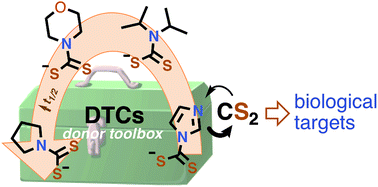当前位置:
X-MOL 学术
›
Chem. Sci.
›
论文详情
Our official English website, www.x-mol.net, welcomes your feedback! (Note: you will need to create a separate account there.)
Uncaging carbon disulfide. Delivery platforms for potential pharmacological applications: a mechanistic approach
Chemical Science ( IF 8.4 ) Pub Date : 2017-09-04 00:00:00 , DOI: 10.1039/c7sc02727c Anthony W. DeMartino 1, 2, 3, 4 , Maykon Lima Souza 1, 2, 3, 4 , Peter C. Ford 1, 2, 3, 4
Chemical Science ( IF 8.4 ) Pub Date : 2017-09-04 00:00:00 , DOI: 10.1039/c7sc02727c Anthony W. DeMartino 1, 2, 3, 4 , Maykon Lima Souza 1, 2, 3, 4 , Peter C. Ford 1, 2, 3, 4
Affiliation

|
We describe the kinetics of the formation and decay of a series of dithiocarbamates under physiological conditions. The goal is to provide a toolbox of compounds that release CS2 by well-defined kinetics in such media. Carbon disulfide is a known environmental toxin, but there is fragmentary evidence suggesting that CS2 may have bioregulatory and/or therapeutic roles in mammalian biology. Further investigation of such roles will require methodologies for controlled delivery of this bioactive small molecule to specific targets. Reported here are mechanistic and computational studies of CS2 release from a series of dithiocarbamate anions (DTCs), where R2N represents several different secondary amido groups. The various DTCs under physiologically relevant conditions show a tremendous range of reactivities toward CS2 dissociation with decay lifetimes ranging from ∼2 s for imidazolidyldithiocarbamate (ImDTC−) to ∼300 s for diisopropyldithiocarbamate (DIDTC−) to >24 h for pyrrolidinyldithiocarbamate (PDTC−) in pH 7.4 phosphate buffer solution at 37 °C. Thus, by making the correct choice of these tools, one can adjust the flux of CS2 in a biological experiment, while the least reactive DTCs could serve as controls for evaluating the potential effects of the dithiocarbamate functionality itself. Kinetics studies and density functional calculations are used to probe the mechanism of DTC− decay. In each case, the rate of CS2 dissociation is acid dependent; however, the DFT studies point to a mechanistic pathway for ImDTC− that is different than those for DIDTC−. The role of general acid catalysis is also briefly probed.
中文翻译:

开笼的二硫化碳。潜在药理学应用的递送平台:一种机械方法
我们描述了在生理条件下一系列二硫代氨基甲酸酯的形成和衰变的动力学。目的是提供在这类介质中通过明确定义的动力学释放CS 2的化合物的工具箱。二硫化碳是一种已知的环境毒素,但是有零碎的证据表明CS 2在哺乳动物生物学中可能具有生物调节和/或治疗作用。对这些作用的进一步研究将需要用于控制该生物活性小分子向特定靶标递送的方法。此处报道的是从一系列二硫代氨基甲酸酯阴离子(DTC)释放CS 2的机理和计算研究,其中R 2N代表几个不同的仲酰胺基。生理相关的条件下的各种故障码显示出对CS反应性的极大范围2离解与衰减寿命范围从〜2个S表示imidazolidyldithiocarbamate(ImDTC - )对异丙基二到约300秒(DIDTC - )到> 24小时用于pyrrolidinyldithiocarbamate(PDTC -)在pH 7.4磷酸盐缓冲溶液中于37°C加热。因此,通过正确选择这些工具,可以调节CS 2的通量在生物实验中,反应性最低的DTC可以用作评估二硫代氨基甲酸酯功能性本身潜在影响的对照。动力学研究和密度泛函计算用于探测DTC的机制-衰变。在每种情况下,CS 2的解离速率均取决于酸。然而,DFT研究指出,一种机械的途径ImDTC -比那些DIDTC不同- 。还简要探讨了一般酸催化的作用。
更新日期:2017-09-25
中文翻译:

开笼的二硫化碳。潜在药理学应用的递送平台:一种机械方法
我们描述了在生理条件下一系列二硫代氨基甲酸酯的形成和衰变的动力学。目的是提供在这类介质中通过明确定义的动力学释放CS 2的化合物的工具箱。二硫化碳是一种已知的环境毒素,但是有零碎的证据表明CS 2在哺乳动物生物学中可能具有生物调节和/或治疗作用。对这些作用的进一步研究将需要用于控制该生物活性小分子向特定靶标递送的方法。此处报道的是从一系列二硫代氨基甲酸酯阴离子(DTC)释放CS 2的机理和计算研究,其中R 2N代表几个不同的仲酰胺基。生理相关的条件下的各种故障码显示出对CS反应性的极大范围2离解与衰减寿命范围从〜2个S表示imidazolidyldithiocarbamate(ImDTC - )对异丙基二到约300秒(DIDTC - )到> 24小时用于pyrrolidinyldithiocarbamate(PDTC -)在pH 7.4磷酸盐缓冲溶液中于37°C加热。因此,通过正确选择这些工具,可以调节CS 2的通量在生物实验中,反应性最低的DTC可以用作评估二硫代氨基甲酸酯功能性本身潜在影响的对照。动力学研究和密度泛函计算用于探测DTC的机制-衰变。在每种情况下,CS 2的解离速率均取决于酸。然而,DFT研究指出,一种机械的途径ImDTC -比那些DIDTC不同- 。还简要探讨了一般酸催化的作用。

























 京公网安备 11010802027423号
京公网安备 11010802027423号